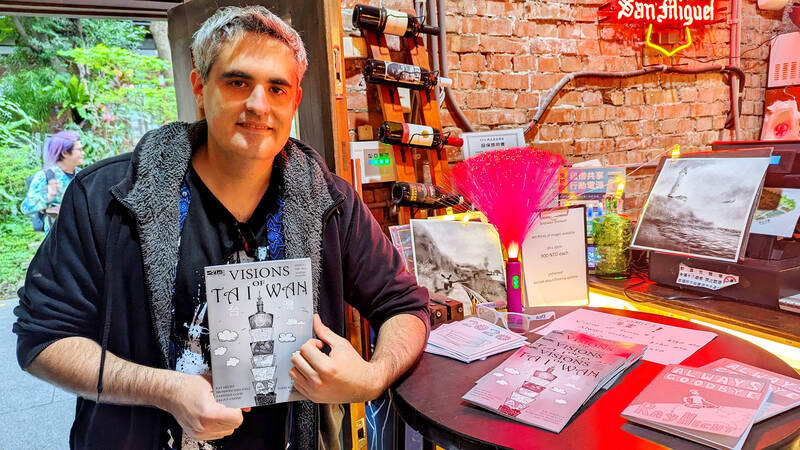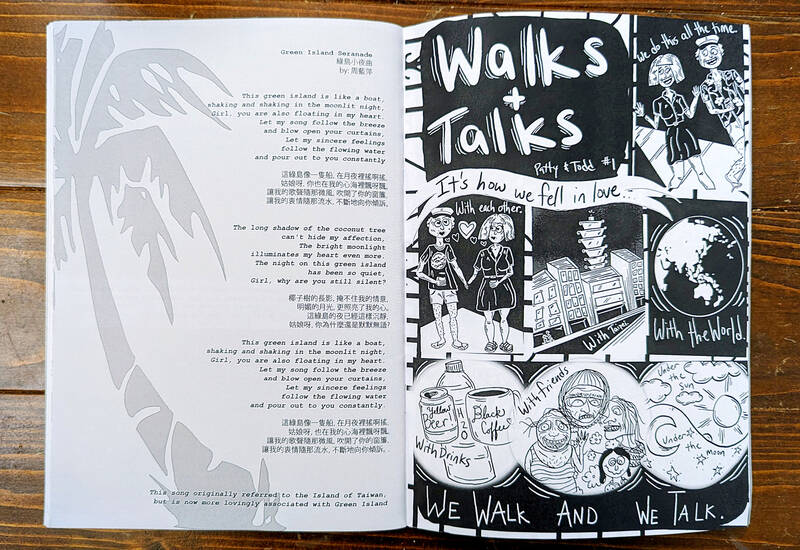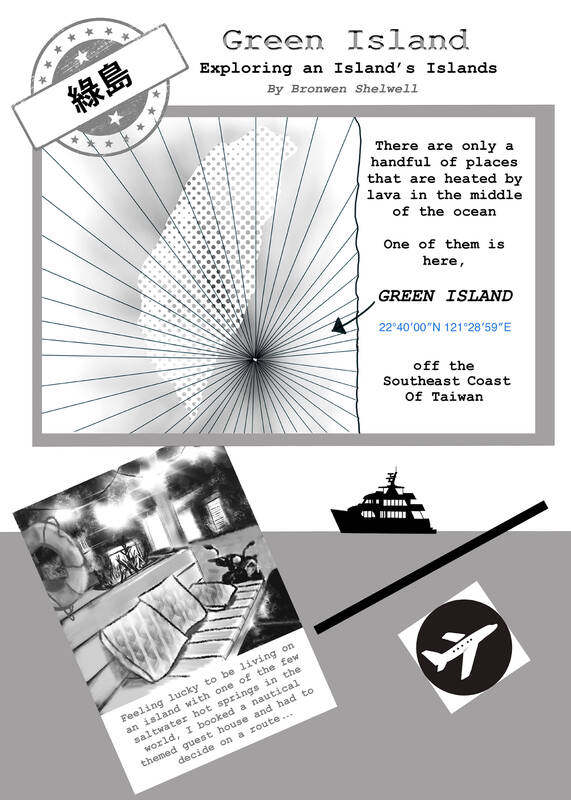One of Patty Hogan’s more memorable moments in Taiwan was watching a kid quickly eat an entire rice triangle with seaweed at 7-Eleven. He then puked it up.
“It was such a metaphor for life, art, consumerism, religion, politics and everything we love, but it was also really funny,” the American artist writes in her humorous piece “Walks and Talks” for the inaugural issue of Visions of Taiwan, an English-language comic anthology that celebrated its official release on Sunday.
Containing seven stories employing a wide range of graphic styles and voices, the focus of this black-and-white, 48-page issue is about the Taiwan experiences of the foreign creators — who hail from Malaysia, Canada, the US and South Africa. There are a few requisite “how I ended up in Taiwan” tales, but there are also stories on how to get your scooter’s license.

Photo: Han Cheung, Taipei Times
Although anthology editor Ray Hecht sees himself more of a writer, he’s been experimenting with graphic novels in the past few years, drawing inspiration from the indie spirit of eccentric American cartoonist Robert Crumb and the punk zine aesthetic. He published in 2019 the autobiographical Always Goodbye, and last year began approaching artists he’d met to contribute personal narratives to what became Visions of Taiwan.
“There was a bit of a learning curve. Some people are just artists rather than storytellers and writers,” Hecht says. “I really had to beg people to give me a short script first. You may have an image in your mind, but it doesn’t translate to the page very well until you have experience [with comics].”
Hecht’s contribution is about how he finally got his scooter license on the fourth attempt.

Photo: Han Cheung, Taipei Times
“Every time I went there I learned a new rule,” he says. “I kept failing and starting over until it consumed me, and it became my go-to story when people asked me what I’ve been up to lately,” he says.
Bronwen Shelwell, an international school art teacher from South Africa, depicted a trip to Green Island in her piece, which was more of a series of digital paintings rather than a conventional comic. A colleague saw her finishing the piece at the office and told her about the classic song Green Island Serenade (綠島小夜曲), which is translated into English at the end of the story.
“I think it’s a really nice first introduction on what Taiwan means to people,” she says.

Photo courtesy of Bronwen Shelwell
This issue was a lot about people’s various first experiences, but she hopes that they can delve deeper for the next one.
“What I love is that we all got stuck here due to COVID-19, so we all had to move past that first experience to a solid three years of living here and not going anywhere else,” she says. “Otherwise, it’s often a lot of new people arriving and telling that same story over and over, but now I think people have more to draw from.”
Hecht wanted the second issue to feature fictional narratives, but many contributors have said that they prefer to stick to the autobiographical.
“It can be creative nonfiction where you tell a true story within the structure of a fictional narrative. As people get more experienced, we’ll be able to do more,” he says.
Taiwanese voices are welcome too, he says, as long as they’re able to contribute in English. Hecht hopes to publish it twice a year.
So far, the book will be available at Vinyl Decision at Huashan 1914 Creative Park, Comic Trap (漫坑) in Ximending, the Red Room and through Amazon.

Anyone who has been to Alishan (阿里山) is familiar with the railroad there: one line comes up from Chiayi City past the sacred tree site, while another line goes up to the sunrise viewing platform at Zhushan (祝山). Of course, as a center of logging operations for over 60 years, Alishan did have more rail lines in the past. Are any of these still around? Are they easily accessible? Are they worth visiting? The answer to all three of these questions is emphatically: Yes! One of these lines ran from Alishan all the way up to the base of Jade Mountain. Its

The entire saga involving the Taiwan People’s Party (TPP) and its Chairman Ko Wen-je (柯文哲) continues to produce plot twists at such a rapid pace that fiction publishers would throw it out for being ridiculously improbable. This past week was particularly bizarre, but surprisingly the press has almost entirely ignored a big story that could have serious national security implications and instead focused on a series of salacious bombshell allegations. Ko is currently being held incommunicado by prosecutors while several criminal investigations are ongoing on allegations of bribery and stealing campaign funds. This last week for reasons unknown Ko completely shaved

The only geopolitical certainty is that massive change is coming. Three macro trends are only just starting to accelerate, forming a very disruptive background to an already unsettled future. One is that technological transformations exponentially more consequential and rapid than anything prior are in their infancy, and will play out like several simultaneous industrial revolutions. ROBOT REVOLUTION It is still early days, but impacts are starting to be felt. Just yesterday, this line appeared in an article: “To meet demands at Foxconn, factory planners are building physical AI-powered robotic factories with Omniverse and NVIDIA AI.” In other words, they used AI

The rhythms of bustling, working-class Mumbai are brought to vivid life in All We Imagine as Light. The stunning narrative debut of filmmaker Payal Kapadia explores the lives of three women in the city whose existence is mostly transit and work. Even that isn’t always enough to get by and pay the rent. One of the women, a widow, recently retired from working her whole life at a city hospital, Parvaty (Chhaya Kadam), is even facing eviction. The other two, roommates and co-workers in the maternity ward are in different parts of life. Prabha (Kani Kusruti) has a husband from an